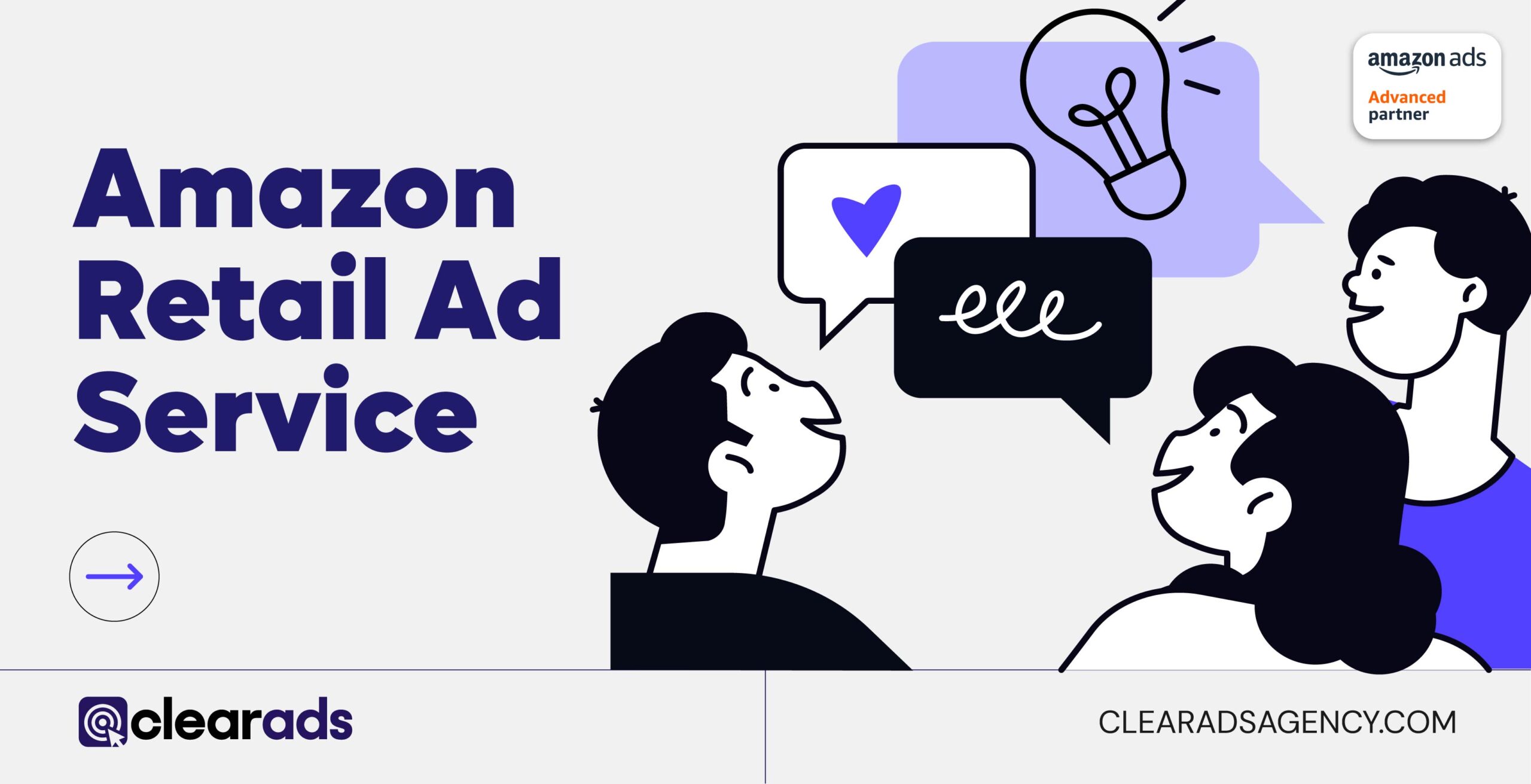This article starts with an introduction of what is Amazon Retail Ad Service and how it works, and covers what retail media networks are and what is driving their rise. It outlines the role and value proposition of Amazon Retail Ad Service for retailers, brands, and shoppers, then details the technologies that power the platform, including AWS, machine learning, and AWS Clean Rooms. The article highlights the benefits for retailers, advertisers, and shoppers, explains how to set up the service for both parties, and illustrates real-world usage through early adopters. It also compares Amazon’s service with Walmart Connect and ends with the strategic implications for brands, the retail ecosystem, and the future of advertising.
Amazon Retail Ad Service expands digital advertising by allowing third-party retailers to run contextually targeted ads on their own platforms using Amazon’s ad infrastructure. These ads are powered by machine learning and hosted securely on AWS, ensuring privacy and performance. Retailers retain control over ad formats, placements, and user journeys, while advertisers manage campaigns using familiar tools within Amazon Ads console.
Retail media networks, built on first-party shopper data, are gaining traction as retailers seek to monetise their digital real estate through targeted and contextually relevant ads.
Advertisers benefit from broader reach across external retailer environments, unified campaign execution, and real-time performance analytics. Shoppers are served personalised ads within native environments, improving engagement and streamlining the path to purchase.
Early adopters such as iHerb, Weee!, and Oriental Trading Company have reported increased engagement and conversions. The service allows both retailers and advertisers to use existing Amazon Ads infrastructure, democratising access to advanced retail media capabilities. Positioned alongside Walmart Connect and major ad tech platforms like Criteo, Amazon’s offering introduces a decentralised model designed to reshape the competitive landscape of retail advertising.
How Amazon’s Retail Ad Service Transforms Advertising?
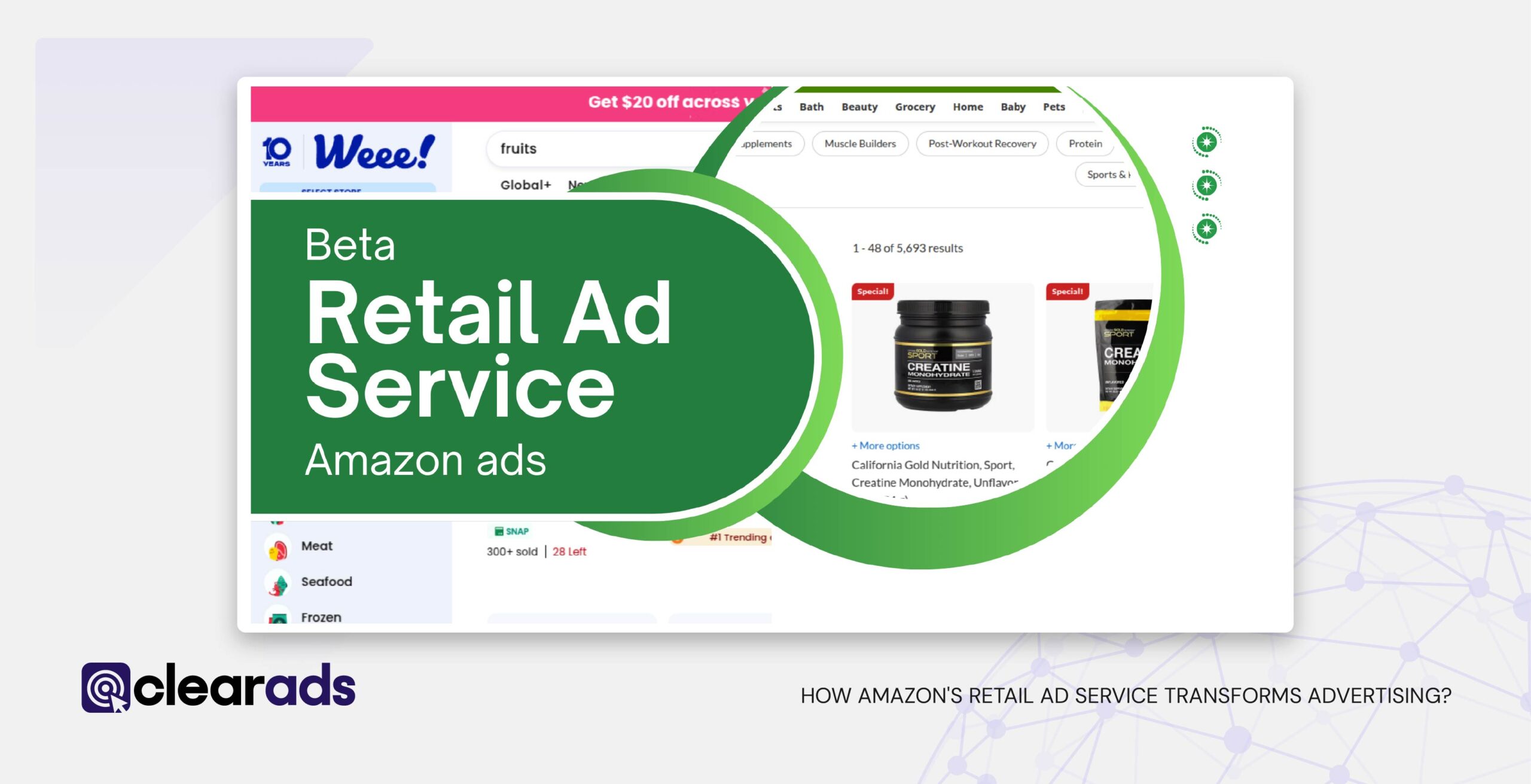
Introduction
Amazon’s advertising business has evolved into one of the largest digital advertising platforms globally, positioned third behind Alphabet and Meta in the United States. In Q4 2024, Amazon generated $14.3 billion in advertising revenue, illustrating the scale and profitability of its advertising operations relative to its retail and cloud computing segments, which brought in $61.4 billion and $27.4 billion respectively, during the same period.
Originally focused on sponsored product ads within its own marketplace, Amazon’s advertising model relied on keyword-targeted placements integrated into search and product pages. Over time, Amazon scaled this strategy by embedding more sponsored placements into its core shopping environment, aligning ads with real-time shopping behaviour and preferences.
The launch of Amazon Retail Ad Service represents a major progression in this journey. Amazon Retail Ad Service is a cloud-based advertising platform developed by Amazon Ads that enables multi-brand U.S. retailers with e-commerce websites or mobile applications to deliver contextually relevant sponsored product ads directly within their own digital storefronts. The platform is hosted on Amazon Web Services (AWS) and operates independently of Amazon’s core retail business, ensuring data privacy through segregated infrastructure and AWS Clean Rooms.
Retailers integrate Amazon’s machine learning-powered advertising models, which are trained on trillions of shopping signals, to optimise ad placements across search, browse, and product detail pages. These models enhance product discoverability and shopper engagement by dynamically serving ads based on real-time context, such as product availability, category views, and search queries
Retailers retain full control over ad display parameters, including placement, volume, format, and post-click interactions such as directing users to a quick view, product detail page, or add-to-cart feature. Shoppers remain within the retailer’s site or app throughout the journey, completing purchases without redirection to Amazon, which maintains brand integrity and user experience continuity.

Brands participating in the Retail Ad Service can launch and manage campaigns through the Amazon Ads console or API integrations, regardless of whether they sell on Amazon. Campaign creation, targeting, budgeting, and measurement are handled via familiar interfaces, enabling streamlined operations across multiple retail platforms.
Amazon has also incorporated robust measurement and reporting tools, including data insights from AWS Clean Rooms. These tools enable both advertisers and retailers to analyse performance, optimise campaigns, and generate anonymised reports in a privacy-compliant framework.
What Are Retail Media Networks (RMNs)?
Retail Media Networks (RMNs) are digital advertising ecosystems operated by retailers that enable brands to display targeted advertisements on the retailer’s owned digital properties, such as websites, apps, and digital displays. These networks utilise first-party shopper data, like purchase history, search behaviour, and page views, to deliver highly relevant ads near high-intent moments, such as during product searches or on product detail pages. The key advantage of RMNs is their ability to connect ad exposure directly to purchase activity, making them an effective tool for driving sales and measuring return on investment.
What’s Fueling the Rapid Growth of RMNs?
The rapid adoption of RMNs is being driven by growing restrictions on third-party cookies and increasing demand for measurable, high-intent advertising. Retailers are capitalising on their access to first-party data by building monetisation strategies around their digital storefronts. RMNs allow brands to advertise in a contextually relevant manner within shopping environments where consumers are already primed to purchase. Amazon’s Retail Ad Service, announced at CES 2025, exemplifies this momentum. The platform enables mid-sized retailers to launch campaigns using Amazon’s ad infrastructure while maintaining control over branding and customer experience. This lowers technical barriers and positions RMNs as scalable and standardised digital advertising solutions.
What is the Role and Value Proposition of Amazon Retail Ad Service for Retailers, Brands, and Shoppers?
Amazon Retail Ad Service provides a unified advertising infrastructure that benefits three primary stakeholders: retailers, brands, and shoppers. It functions as a cloud-based ad technology platform enabling monetisation of e-commerce traffic through contextually relevant sponsored product ads.
For Retailers:
Retailers integrate Amazon Retail Ad Service through simple API connections or the Amazon Ads console to activate ad inventory across their digital properties. The core value lies in revenue generation, improved shopper engagement, and operational efficiency. Retailers retain full control over ad formats, placements, frequency, and post-click destinations.
Additional benefits for retailers include:
- Access to Amazon’s advertiser network within the Amazon Ads console.
- Measurement and campaign reporting within a centralised interface.
- Secure infrastructure on AWS with retailer data siloed via access-controlled environments.
The service is in beta with mid-sized retailers including iHerb, Weee!, and Oriental Trading Company, and aims to scale across the U.S. market.
For Brands:
Brands benefit from seamless campaign creation and reporting through Amazon’s existing tools, without the requirement to sell on Amazon itself. They can advertise on participating retailer sites, thereby expanding reach beyond Amazon’s marketplace. Campaigns are managed using the same metrics and dashboards, supporting cross-retailer campaign deployment.
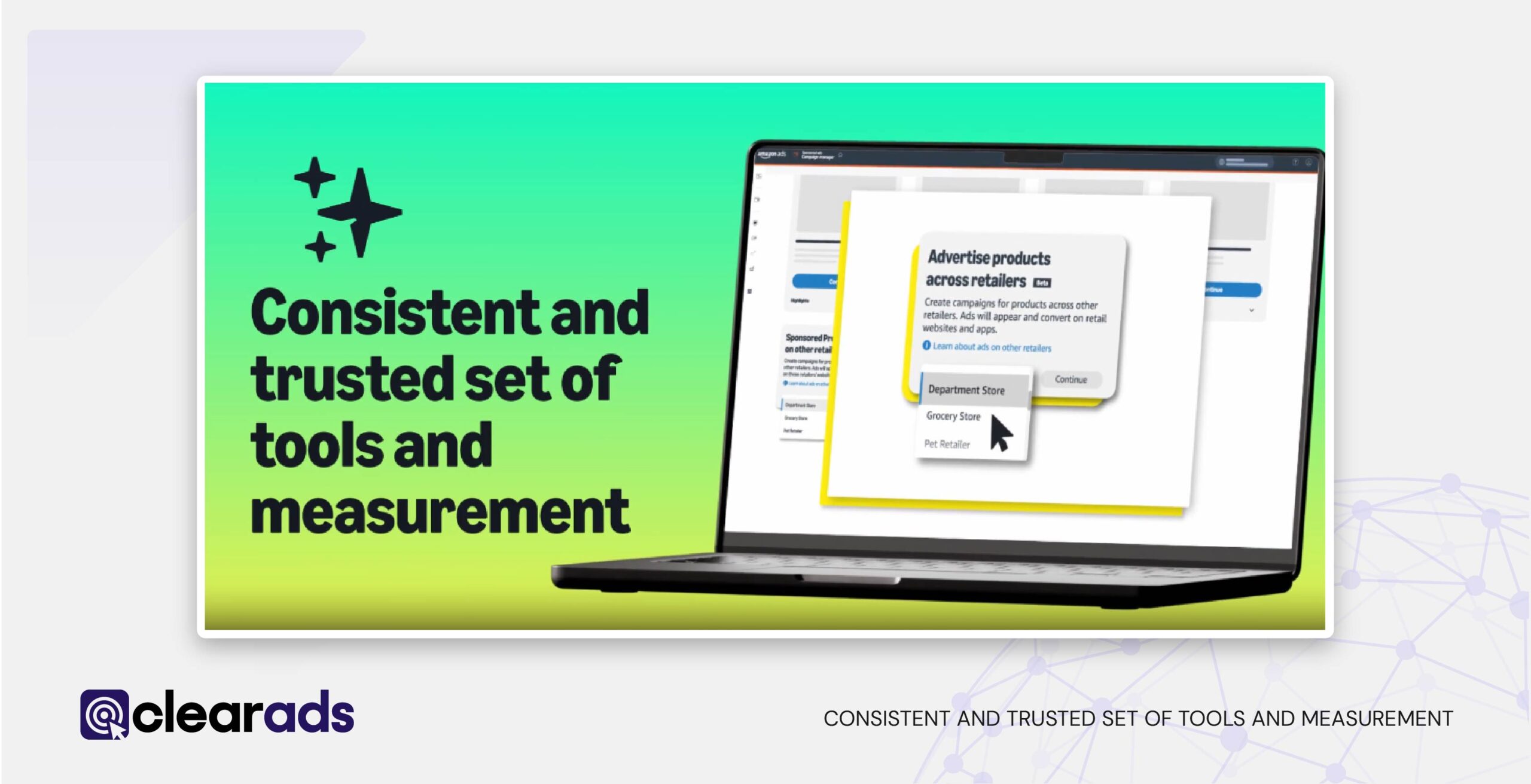
The system enables:
- Unified campaign management across multiple retail partners.
- High-precision targeting based on contextual relevance and shopper data.
- A scalable entry point for brands to access new audiences with minimal infrastructure investment.
For Shoppers:
Shoppers engage with ads in native formats across retailer websites and apps. Ads appear where they are most relevant, during search queries, while browsing categories, or on product detail pages. The experience is uninterrupted and tailored using contextual triggers such as keyword queries and product attributes. Shoppers remain within the retailer ecosystem to complete purchases, which eliminates friction in the buying journey.
Additional shopper-facing enhancements include:
- Personalised recommendations that facilitate product discovery.
- Visibility into availability and price to inform purchase decisions.
- Ad interactions that lead to quick product views, detailed pages, or direct cart additions.
What Technologies Power Amazon’s Retail Ad Service?
The technologies behind Amazon Retail Ad Service integrate cloud computing, machine learning, and privacy-centric analytics. These systems collectively support scalable, secure, and contextually intelligent advertising across multiple retail platforms.
How Does AWS Cloud Infrastructure Enable Amazon Retail Ad Service?
Amazon Retail Ad Service operates entirely on Amazon Web Services (AWS), which supplies the core infrastructure, data processing capabilities, and enterprise-grade security protocols required for scalable retail ad delivery.
Each participating retailer manages its data within its own AWS account, ensuring data isolation from Amazon’s retail operations and providing administrative control over data access, ad display configurations, and user interactions such as product page redirection or add-to-cart functionality.
AWS Clean Rooms support privacy-preserving collaboration between retailers and advertisers by enabling shared analytics without exposing personally identifiable information. This ensures compliance with regulatory requirements while providing aggregated insights for performance optimisation.
What Role Does Machine Learning Play in Contextual Targeting?
Amazon Retail Ad Service employs machine learning (ML) models to enable contextual ad targeting. These models process multiple real-time inputs such as search queries, browsing behaviour, product attributes, and availability. This allows the system to dynamically deliver Sponsored Product ads aligned with user intent and on-page content.
ML models replace static or keyword-based systems, allowing contextual ad placements that match inventory availability at the retailer level. For example, a shopper viewing the health supplement category on iHerb will be shown ads relevant to that category and retailer stock.
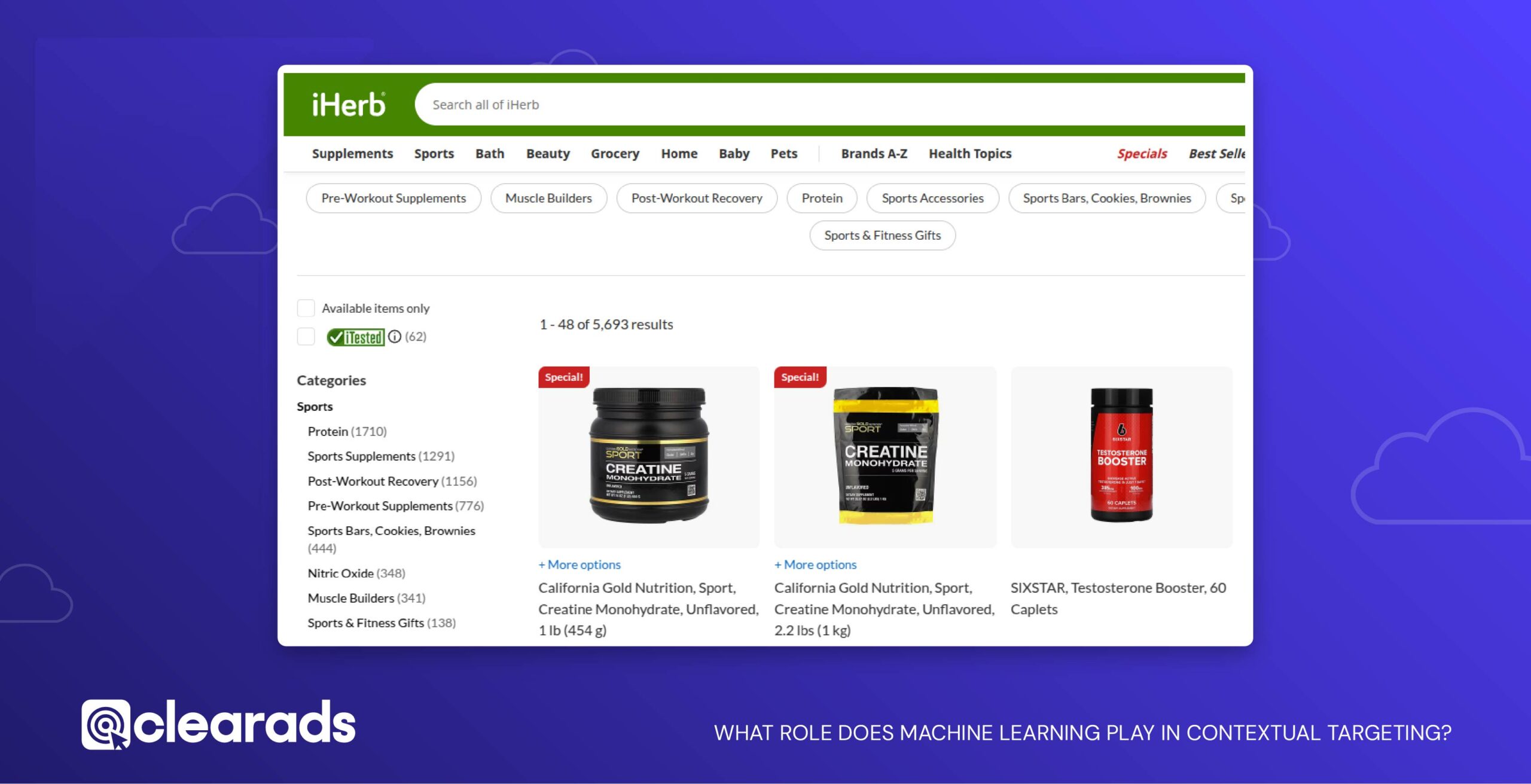
Real-time optimisation is driven by feedback from key performance metrics including impressions, click-through rate (CTR), conversion rate, and return on advertising spend (ROAS). These inputs enable continuous algorithmic refinement to improve ad placements. Advertisers access centralised performance data via the Amazon Ads console, which consolidates reporting across multiple retailers for standardised measurement and enhanced decision-making.
What is AWS Clean Rooms and how does it enable Privacy Management in Amazon Retail Ad Service?
AWS Clean Rooms is a privacy-focused analytics service that facilitates collaborative analysis without exposing user-level data. It underpins the privacy model for Amazon Retail Ad Service by enabling aggregated, anonymised reporting between retailers and advertisers within the AWS environment.
Retailers retain full control over their first-party data within their own AWS accounts. Clean Rooms apply secure multiparty computation protocols, which allow only pre-approved query outputs, preventing access to raw or identifiable customer data. For instance, retailers can measure ad-attributed conversion rates by demographic without disclosing individual customer records.
Clean Rooms also facilitate unified campaign measurement across retail partners. Advertisers receive consistent performance insights while maintaining compliance with data protection regulations such as GDPR and CCPA. The system enforces encryption, access control, and query-level permissions to prevent data leakage or misuse. Centralised reporting enhances campaign optimisation across platforms while safeguarding consumer trust.
What Are the Benefits of Amazon Retail Ad Service?
Amazon Retail Ad Service delivers multi-sided benefits by enabling retailers, advertisers, and shoppers to interact through a unified advertising infrastructure. It enhances monetisation, operational efficiency, and contextual relevance across digital commerce environments.
What Are the Benefits for Retailers Using Amazon Retail Ad Service?
Amazon Retail Ad Service enables online retailers to integrate Amazon Ads technology into their websites and apps using Amazon Web Services (AWS). It supports contextual ad delivery on search, browse, and product detail pages using real-time signals such as availability, pricing, and user queries.
Retailers retain control over ad formats, placements, and post-click experiences. Ad options include product detail redirection, ‘quick view’, or direct cart additions. Customers remain within the retailer’s digital environment throughout the journey.
Reported outcomes include improved product discovery, increased engagement, and stronger conversion metrics. The system provides immediate access to Amazon’s advertising demand pool and two decades of machine learning and ad tech development.
Retailers opting in can list inventory through Amazon Ads’ console and APIs, enabling advertisers to launch and manage cross-retailer campaigns from a central interface. This facilitates streamlined operations, consistent performance analysis, and improved budget efficiency.
Performance analytics are processed within AWS Clean Rooms. This ensures privacy-compliant, anonymised insights without exposing proprietary data. Retailers use these insights to align ad placements with demand signals and optimise campaigns.
Why Does Amazon Retail Ad Service Matter for Retailers?
Amazon Retail Ad Service allows third-party retailers to embed Amazon’s advertising into their own ecosystems. This approach increases monetisation opportunities and preserves brand ownership. Unlike platform-bound solutions such as Walmart Connect, which restricts campaigns to in-house properties, Amazon’s model enables retailers to operate independently while benefiting from enterprise-scale technology.
Retailers generate incremental revenue through ad monetisation without compromising user experience. Integration of contextual placements based on on-site data ensures relevance and performance. According to iHerb’s SVP of Global Marketing, Neil Folgate, the presence of over 1,200 shared brands already active on Amazon Ads creates a seamless connection between advertisers and iHerb’s audience.
How Can Retailers Measure Results from Amazon Retail Ad Service?
Retailers access campaign metrics using Amazon Ads’ console and APIs. Reportable events include impressions, clicks, views, add-to-cart actions, and completed conversions. Reports are also available by keyword and category to support granular performance analysis.
All measurement data is processed through AWS Clean Rooms. This ensures compliance with data privacy standards while enabling standardised KPIs and campaign benchmarking. Shared attribution models support cross-platform consistency in decision-making and resource planning.
What Are the Benefits of Amazon Retail Ad Service for Advertisers?
Advertisers gain expanded reach across external retailer environments beyond Amazon’s core platform. Campaigns deployed through the Retail Ad Service reach digital storefronts of participating retailers.
Using a unified Amazon Ads interface, advertisers manage campaigns, track performance, and execute optimisations without switching systems. This reduces operational overhead and improves campaign execution speed.
What Are the Benefits of Amazon Retail Ad Service for Shoppers?
Shoppers encounter relevant ads that reflect current availability, pricing, and interest patterns. These ads surface on retailer search, browse, and product pages, improving product discovery and enabling timely decision-making.
Interactive ad formats, including add-to-cart and quick view features, reduce friction during product engagement. The integrated infrastructure supports rapid page performance, ensuring user experience continuity without loading delays.
Amazon’s ad-serving models further support real-time relevance, enhancing shopper interaction by delivering product suggestions aligned with individual behaviour and intent.
Summary Table of Stakeholder Benefits
| Stakeholder | Benefit | Excellent |
|---|---|---|
| Advertisers | Reach across external retailer networks | Campaigns deployed via iHerb, Weee!, Tilly’s |
| Advertisers | Unified campaign management and reporting | Amazon Ads console and API integrations |
| Advertisers | Intent-based contextual targeting | Ads tailored to search queries and product views |
| Advertisers | Secure, privacy-compliant analytics | Aggregated insights via AWS Clean Rooms |
| Shopper | Contextual, personalised ad experiences | Ads aligned with product relevance and pricing |
| Shopper | Enhanced user interaction with ads | Add-to-cart and quick-view features |
| Shopper | Frictionless product discovery | Optimised delivery on search, browse, and product pages |
| Retailers | Monetisation of digital traffic | Ad placements integrated into their own storefronts |
| Retailers | Brand and experience control | Customise formats, placements, and interactions |
| Retailers | Access to Amazon’s ad infrastructure | Scalable ML-based relevance and delivery |
| Retailers | Data security with isolated processing | Operates within AWS with strict access control |
How to Set Up Amazon Retail Ad Service
Amazon Retail Ad Service is a cloud-based advertising technology designed for multi-brand retailers with digital storefronts. It enables contextual ad placement on retailer websites and apps, powered by Amazon’s advertising algorithms and infrastructure. The setup process varies for retailers and advertisers.
How Do Retailers Set Up Amazon Retail Ad Service?
Retailers initiate access to the Amazon Retail Ad Service by submitting a demo request form through Amazon Ads.
Retailer Onboarding Steps:
- Demo Request Submission: Retailers fill out a contact form providing key business information, including name, email, website, and business phone number. Submission grants eligibility to explore service capabilities.
- API Integration: Once accepted, retailers integrate Amazon’s ad service APIs into their digital properties. These APIs enable ad placements across search results, browse categories, and product detail pages.

- Ad Control and Placement: Retailers maintain full control over ad visibility, frequency, and contextual alignment.
- Privacy and Data Collaboration: Ad targeting and measurement are performed using contextual signals only, such as search terms and product attributes. Data sharing occurs via AWS Clean Rooms, enabling privacy-safe collaboration. Retailer data is isolated from Amazon’s core operations, ensuring data confidentiality.
- Use Case Examples: Current retailers include Weee (grocery), iHerb (supplements), and Oriental Trading Company (party supplies). Each has implemented contextual ad placements to drive onsite product discovery and conversion.
How Do Advertisers Set Up Sponsored Products Across Retailers?
Advertisers access Sponsored Products across Retailers via their existing Amazon Ads account. This allows brands to place contextual ads on retailer websites that are part of the Amazon Retail Ad Service network.
Advertiser Setup Steps:
- Account Registration: Advertisers register for Amazon Ads or log in using existing credentials.
- Campaign Initiation: From the “All Campaigns” page, advertisers click “Create campaign” and choose the “advertise products across retailers” tile.
- Retailer and Product Selection: Advertisers select one or more participating retailers and then add the products to be advertised. These products must already be part of the selected retailer’s catalogue.
- Targeting and Bidding Configuration: Users define targeting parameters using automatic or manual keyword-based strategies. Bidding strategies and budgets are set according to campaign objectives.
- Campaign Settings and Launch: Advertisers configure basic campaign details such as name, duration, and daily spend, then launch the campaign. Ads are displayed natively on the selected retailer’s platform, and purchases are completed without redirecting shoppers to Amazon.
How Is Amazon Retail Ad Service Used in Practice?
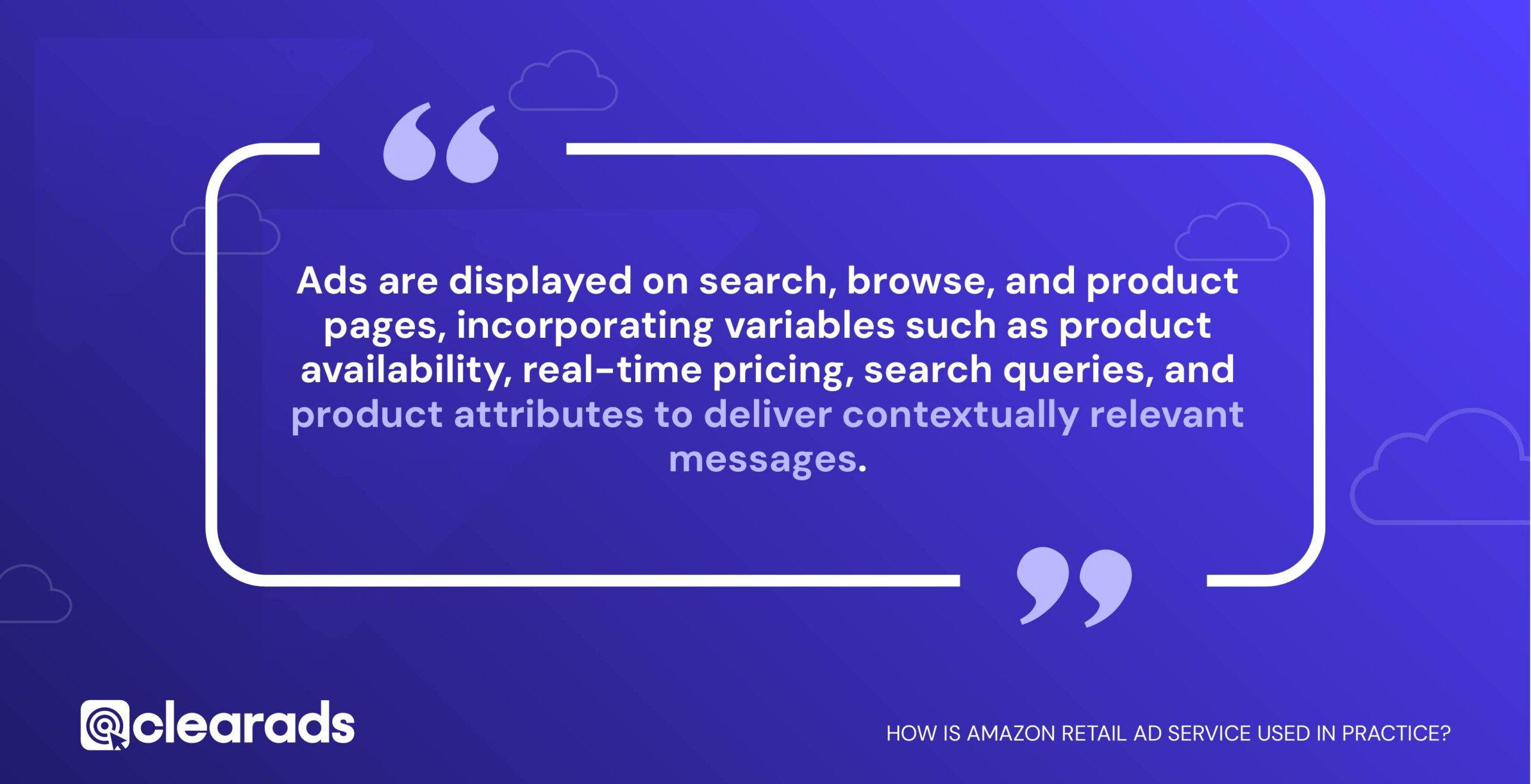
The early adopters are using the platform to enhance product discoverability and shopper engagement through contextual advertising integrated within their e-commerce ecosystems. Ads are displayed on search, browse, and product pages, incorporating variables such as product availability, real-time pricing, search queries, and product attributes to deliver contextually relevant messages. Purchases occur directly on the retailer’s platform, streamlining the buying experience.
Retailers manage key components such as:
- Ad placement and format
- Click destinations (e.g., product detail, add-to-cart)
- Ad density and creative standards
How Are Advertisers Using Amazon Retail Ad Service?
Advertisers utilise Amazon Retail Ad Service to run Sponsored Products across multiple non-Amazon retailer sites from a single access point. This includes the ability to:
- Select specific retailers
- Target available SKUs on each retailer’s platform
- Set separate budgets and bidding strategies
- View performance reports across platforms within the same reporting infrastructure
Feedback from agencies like Flywheel confirms that this cross-retailer capability centralises campaign operations and enhances reach. Flywheel states that Amazon’s unified access point simplifies media buying and offers a consistent level of campaign control, measurement, and optimisation across retailers.
Advertiser advantages include:
- Centralised campaign management
- Access to contextual advertising tech
- Consistent reporting across platforms
How Does Amazon Retail Ad Service Compare with Walmart Connect?
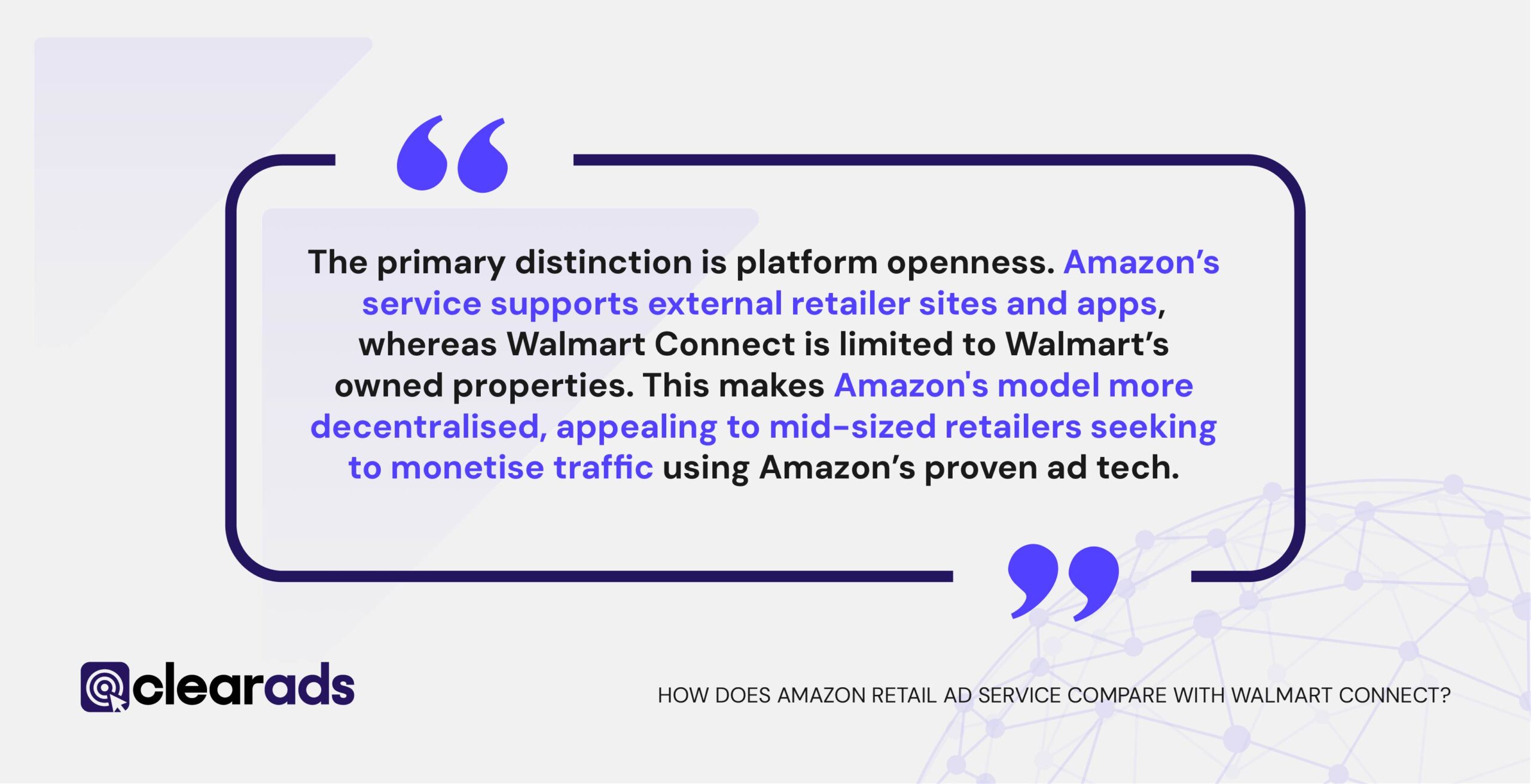
Amazon Retail Ad Service provides third-party retailers with an integrated advertising infrastructure built on AWS, enabling them to run targeted ads on their own digital properties while maintaining control over transactions. By comparison, Walmart Connect operates within Walmart’s own ecosystem, offering ad placements on Walmart.com and its mobile app with in-store options unavailable on Amazon platforms.
The primary distinction is platform openness. Amazon’s service supports external retailer sites and apps, whereas Walmart Connect is limited to Walmart’s owned properties. This makes Amazon’s model more decentralised, appealing to mid-sized retailers seeking to monetise traffic using Amazon’s proven ad tech.
Both platforms support sponsored product formats, video, and display ads, with targeting based on first-party data. However, Amazon’s use of contextual relevance, such as SKU availability, price, and shopper behaviour, extends to participating retailer sites. This cross-platform ad delivery provides advertisers with broader audience reach and enables campaign consolidation under a single interface.
What Are the Strategic Implications?

Amazon’s Retail Ad Service introduces a structural shift in the retail advertising ecosystem. By extending its advanced ad tech to external retailers, Amazon is creating new monetisation opportunities, influencing brand strategies, and reshaping industry dynamics.
For Brands and Agencies
The launch of Amazon Retail Ad Service allows brands and agencies to access a broader advertising infrastructure beyond Amazon’s marketplace. Retailers using the service can now sell ad inventory to Amazon’s advertiser base, enabling brands to reach consumers directly on third-party websites.
This technology integration allows brands to tailor ad placements to specific environments and monitor campaign performance using Amazon’s analytics. The service also helps advertisers optimise reach through campaign-level control over design, ad volume, and placements. With Amazon Ads Measurement tools included, brands gain transparency in performance metrics, enhancing decision-making capabilities.
For agencies, this development creates a centralised media buying environment, reducing the fragmentation typically seen across retail networks. It offers an alternative to managing separate IO-based tenancy models, reducing operational complexity. Brands working with early adopters like iHerb and Weee! can promote products directly on external platforms using Amazon’s retail ad console, ensuring consistency in campaign delivery and measurement across digital properties.
For the Retail Ecosystem
Amazon’s Retail Ad Service offers a scalable advertising infrastructure that significantly reduces the technological and financial barriers traditionally faced by smaller retailers. The service enables retailers to display ads across search, product, and category pages, with control over creative assets, placements, and post-click experiences.
Retailers can maintain control over the customer journey, directing users to product pages, quick views, or direct purchase functions. The integration with AWS ensures retailer data remains separate and private, while AWS Clean Rooms enable anonymised reporting and audience insights. These capabilities address privacy concerns while enhancing campaign performance tracking.
This model disrupts the traditional third-party vendor ecosystem, which often involves high infrastructure costs and delayed insights. The solution removes reliance on tenancy and static insertion order frameworks, introducing real-time data access and simplified API integrations.
Smaller retailers can now monetise web traffic without investing in proprietary ad tech. This creates incremental revenue opportunities and levels the competitive field. For instance, iHerb uses the service to integrate Amazon-sponsored product ads into its website, generating ad revenue while offering contextual promotions. The platform’s transparent performance metrics provide retailers with insights into impressions, CTRs, and conversion rates, facilitating data-driven optimisation.
For the Future of Advertising
Amazon’s Retail Ad Service contributes to the evolution of closed-loop advertising, aligning ad engagement with measurable outcomes on retailer platforms. Unlike traditional ad networks that redirect users to external domains, Amazon enables ad interactions and purchases to occur within the same ecosystem, streamlining the consumer journey.
Retailers have full control over display formats, ad placements, and user flow after ad interaction. For example, they can configure ads to lead directly to quick-view product previews or enable instant add-to-cart actions. This enhances engagement and reduces friction in purchase paths.
Advertisers benefit from consistent campaign infrastructure and access to real-time performance data. Brands can run campaigns through Amazon’s ad console across multiple retailer sites, leveraging familiar tools while accessing new audiences. The service supports catalogue-level targeting, contextual matching, and cross-site measurement.


